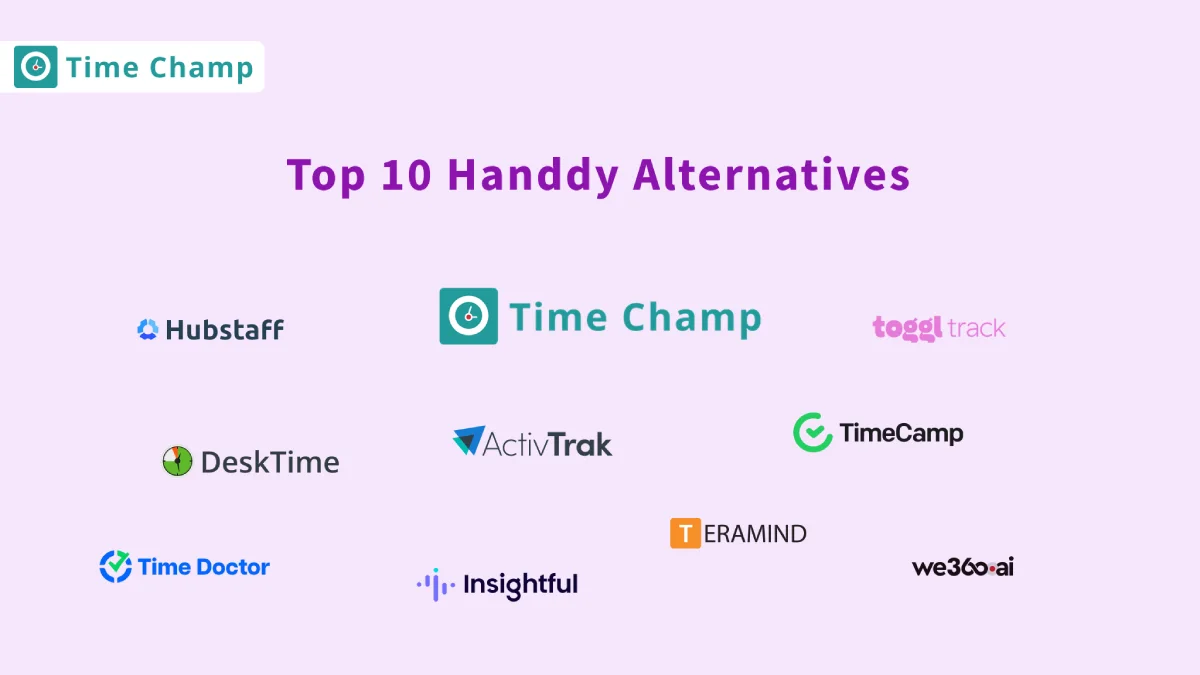Still stuck managing time with clunky tools and outdated spreadsheets?
While Handdy offers simple time tracking, basic reporting, and user-friendly features, it can feels limited. With slow reports, basic features, and lack of flexibility, it's time to search for better Handdy alternatives. As your workflow grows, you need more than just simple time tracking. You need smarter automation, better insights, and tools that actually expands with your team.
That's why I've handpicked the top 10 Handdy alternatives that build a seamless workflow, save time, and boost your team's productivity.
Top Reasons Why Handdy Users are Moving Away From it
Many Handdy users are moving away from it because, while it works well for basic time tracking, it struggles to keep up with growing business needs. When teams expand, they found that Handdy is too simple because they need more advanced features such as a detailed productivity tracking system , budgeting of their projects, or real-time analytics.
Handdy lacks a seamless integration with the most popular solutions such as Slack, Trello, or accounting programs, and this imposes increased manual efforts on the user. If you are looking for flexibility, automation, and a more modern experience, switching to a smarter alternative is becoming the obvious choice.
Key Features of Handdy
- Employee activity : recording helps to track on what tasks employees are working during their work hours.
- Screenshots: capture employee screens at set intervals to monitor work progress and accountability.
- Keystroke activity tracking: measures keyboard activity to understand typing patterns and activity levels.
- Time tracking: allows you to see the time that workers spend on a particular activity, project, or work sessions.
- Attendance tracking: records the time that the workers use to clock in and out, assists in controlling the working hours and shifts.
- Reports: provide a clear summary of employee activity, time spent, and overall productivity metrics.
- Employee behavior tracking: monitors the patterns in work habits to identify productivity trends or concerns.
Limitations of Handdy
- Outdated User Interface : The dashboard and overall design is outdated and less effective compared to newer tools, which can slow down usage and leads to frustrated users.
- Limited Integration : Handdy does not integrate well with most of the tools and applications such as Slack, Trello, or AI accounting software such as QuickBooks, which makes it difficult to automate or streamline the workflows.
- Basic Reporting Features : Reporting features are available in Handdy, but they lack depth and customization. Users are looking for advanced analytics and a detailed breakdown of the work.
- No Mobile App for Time Tracking : Handdy doesn't offer a mobile app support for seamless tracking, which is a dealbreaker for many remote or field employees.
- Lack of Real-Time Notifications : It doesn’t provide instant alerts or updates, which limits its usefulness for active monitoring and quick decision-making.
- Slow Customer Support : Several users have reported delays in getting help from the support team, which becomes very difficult when there are urgent technical issues.
- No Payroll Integration : Businesses who are looking to connect time data directly to payroll processing, Handdy falls short as it doesn’t offer native integrations with payroll software.
- Not Scalable for Larger Teams : Handdy is well-suited for small teams but not for large teams. As your team grows, it may not keep pace with the expansion and managing it will become increasingly difficult.
Best Tools to Replace Handdy and Enhance Efficiency
Tired of Handdy holding your team back? These smarter tools offer better features, faster performance, and give you real results that help your teams work more efficiently.
| Software | Key Features | Pricing | Rating |
|---|---|---|---|
| Time Champ |
|
|
|
| Hubstaff |
|
|
|
| Toggl Track |
|
|
|
| Time Doctor |
|
|
|
| DeskTime |
|
|
|
| TimeCamp |
|
|
|
| We360.ai |
|
|
|
| ActivTrak |
|
|
|
| Insightful |
|
|
|
| Teramind |
|
|
|
1. Time Champ
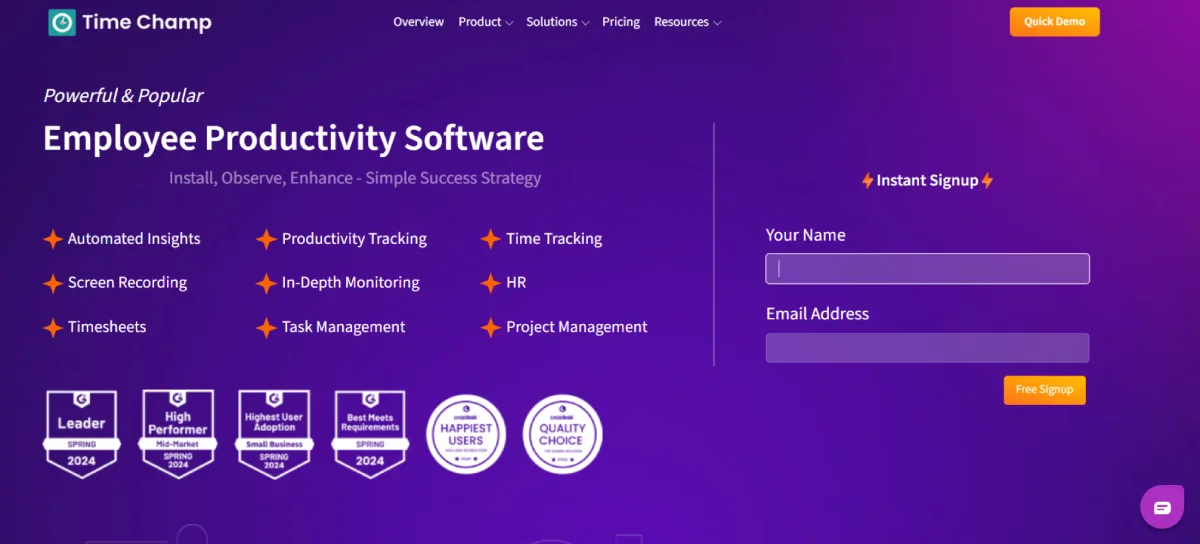
Time Champ is a productivity and time tracking tool created to make workflows more efficient, increase employee accountability, and make it easier to manage teams. Whether your team works in remote, hybrid, or in the office, Time Champ makes you work smarter rather than harder. It allows teams to be focused and get results in a shorter time with real-time insights and automation
Features of Time Champ
- Attendance management: allows you to automate the punch-ins, work out the hours and shift management without manual work.
- Employee monitoring: will allow you to view app usage, idle time, and web activity to be transparent and accountable.
- Geofence & GPS tracking: enables you to monitor the presence of employees when entering or leaving the job site.
- The integration: with Slack, Jira, and Microsoft Teams enables you to conduct workflows more smoothly.
- Leave management: makes it easy to apply, approve and keep track of the employee leaves under one platform.
- Productivity reports : provide you with clear indicators about the use of time so that teams can be focused and effective.
- Project & task management: will allow you to assign and organize tasks and keep track of time for each task.
- Real-Time notifications: notify you immediately when employees are idle, late or log in/out during work hours.
Pros & Cons
| Pros | Cons |
|---|---|
| Boosts Focus and Productivity | Setup can be confusing at first. |
| Affordable pricing plans | Limited offline access |
| Accurate time and activity tracking | Occasional Performance Lags |
| Helps with payroll and attendance | Screenshot control is limited. |
Pricing
- Starter: $3.9/User/Month
- Professional: $6.9/User/Month
- Enterprise: $13.9/User/Month
Ratings
- G2: 4.8
- Capterra: 4.9
2. Hubstaff
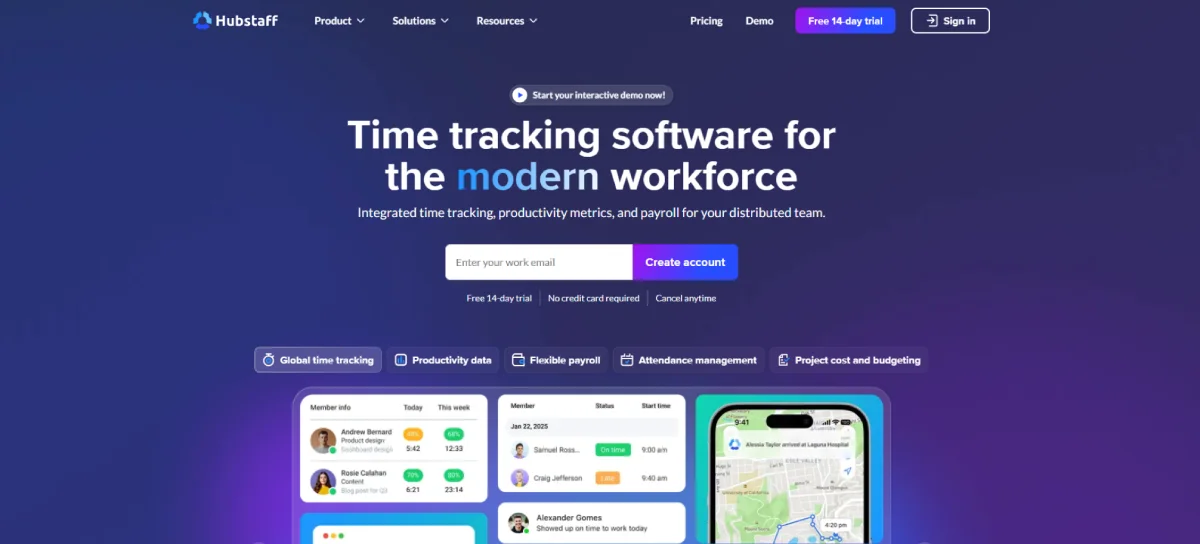
Hubstaff is an effective time tracking and workforce planning software that supports remote, hybrid, and field based teams. It assists companies to keep track of productivity, time, and manage tasks efficiently. Hubstaff helps you maintain a productive team by knowing where the staff is with location tracking , screenshots, and detailed reporting.
Features of Hubstaff
- Time tracking: helps your team to log hours easily using timers on desktop, web, or mobile devices.
- Automatic timesheets : turn tracked hours into ready-to-review records for you.
- Screenshots : and activity tracking give a quick view of what team members are working on during tracked time.
- GPS and geofencing: record where field employees are and start tracking when they reach job sites.
- Scheduling : and attendance make it easy to assign shifts and know who’s late or who misses the work.
- Payroll : and invoicing use tracked hours to calculate pay and send accurate invoices.
- Reports : show how time is spent, how teams are performing, and where costs are going.
Pros & Cons
| Pros | Cons |
|---|---|
| Simple and accurate time tracking | Can feel intrusive to users |
| Clear productivity monitoring | Mobile app has stability issues |
| Good tool integrations | May slow down on some devices |
| Built-in payroll and reports | Interface has a learning curve |
Pricing
- Starter: $4/Seat/Month- 2 Seats minimum
- Grow: $7/Seat/Month- 2 Seats minimum
- Team: $10/Seat/Month -2 Seats minimum
- Enterprise: $25/Seat/Month- 2 Seats minimum
Ratings
- G2: 4.5
- Capterra: 4.6
3. Toggl Track
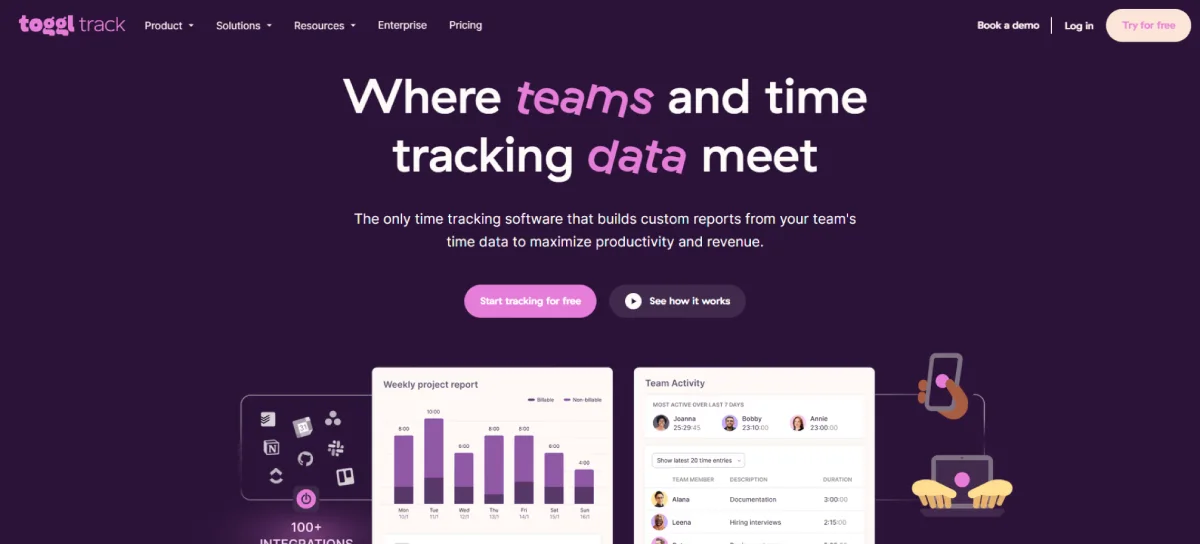
Toggl Track is a time-tracking application meant to be easy to log work, use timers, sync devices, and gain real-time insight into time allocations. It is trusted by more than 70,000 companies and has one-click tracking, offline support, calendar integration, and robust reporting to enable teams and freelancers to increase productivity in a natural way.
Features of Toggle Track
- Time tracking: lets you log hours with one click across devices.
- Idle detection: alerts you when your employees been inactive.
- Calendar integration : allows time entries based on your events.
- Billable rates: help track earnings by project or client.
- Offline mode: keeps track even without internet access.
- Project tagging: organizes work by task, client, or team.
- Reports : show where your time goes with easy summaries.
Pros & Cons
| Pros | Cons |
|---|---|
| Easy to use with a clean interface | Limited client and billing features |
| Works well across devices | UI can feel cluttered after updates |
| Strong reporting and analytics | Occasional sync issues with timers |
| Idle time detection helps with accuracy | Lacks advanced project tools |
Pricing
- Free: $0- free for upto 5 users with limited features.
- Starter: $9/User/Month
- Premium: $18/User/Month
- Enterprise: Custom pricing
Ratings
- G2: 4.6
- Capterra: 4.7
4. Time Doctor
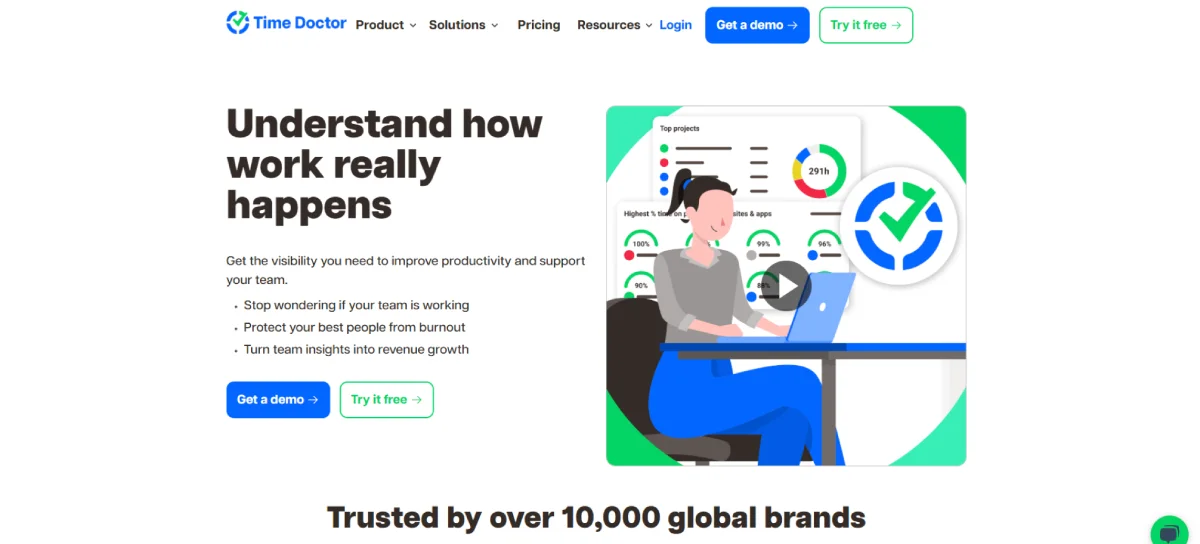
Time Doctor is a remote and hybrid work productivity and time tracking tool. It also assists you in tracking work hours, apps, and website usage. With clear insights, your team can avoid burnout, improve performance, and stay focused on important tasks.
Features of Time Doctor
- Website and app monitoring : shows where time is spent online during work.
- Payroll integration: calculates pay based on tracked time and rates.
- Project and task tracking: helps you see how much time goes into each job.
- Idle time detection: alerts you when there’s no activity in employees for a while.
- Detailed reports: break down hours, tasks, and productivity trends.
- Screenshots: capture work progress at set intervals for added visibility.
- Distraction alerts: pop up when time is spent on non-work websites.
Pros & Cons
| Pros | Cons |
|---|---|
| Accurate and reliable time tracking | Mobile app can be unstable |
| Detailed productivity and activity reports | Some features feel too intrusive |
| Built-in payroll and timesheet tools | Can be pricey for small teams |
| Helpful and responsive support | Occasional syncing and dashboard issues |
Pricing
- Basic: $6.70/User/Month
- Standard: $11.70/User/Month
- Premium: $16.70/User/Month
- Enterprise: Custom plan
Ratings
- G2: 4.4
- Capterra: 4.5
5. DeskTime
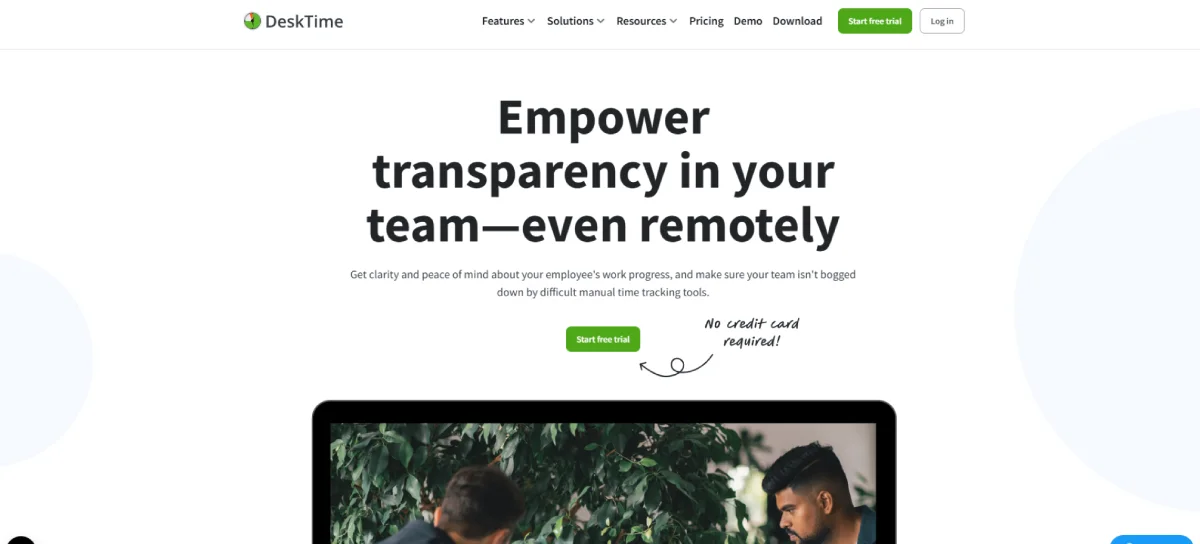
DeskTime is an automatic time‑tracking and productivity platform that quietly works in the background to capture work hours, app and URL usage, screenshots, and more, so teams can improve efficiency without lifting a finger. It’s perfect for hybrid and on‑site teams who want clear insights on work habits, project time, shifts, and attendance, all in one place.
Features of DeskTime
- Automatic time tracking: runs in the background to log work hours.
- App and website tracking : shows which tools and sites are used during work.
- Productivity reports: break down the time spent on productive vs. unproductive activities.
- Screenshots capture: screen activity at a particular set interval for more visibility.
- Project tracking: helps you see how much time goes into each task.
- Shift scheduling: lets you plan work hours and track attendance.
Pros & Cons
| Pros | Cons |
|---|---|
| Automatic background tracking | Inaccurate app classifications |
| Clear productivity insights | Occasional performance lags |
| User-friendly dashboard | Complex advanced setup |
| Solid tool integrations | Premium pricing per user |
Pricing
- Lite: Free/User- Limited features
- Pro: $6.42/User/Month
- Premium: $9.17/User/Month
- Enterprise: Custom for 200+ users
Ratings
- G2: 4.5
- Capterra: 4.5
6. TimeCamp
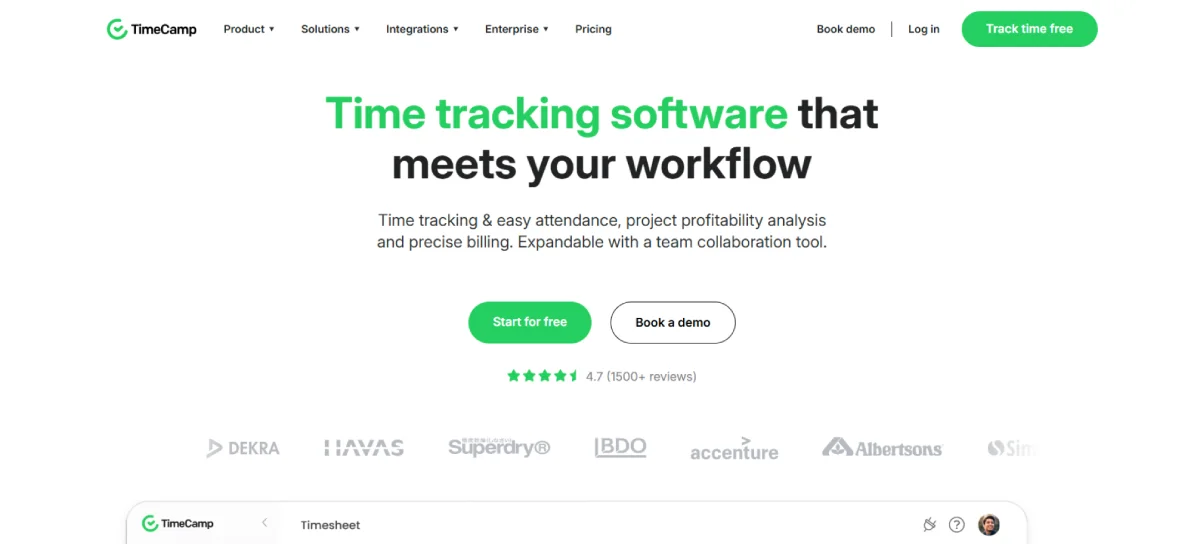
TimeCamp is a smart time-tracking and project management tool that automatically logs work hours, app and website usage, and team attendance, so you can stay on top of productivity and billing without any confusion. It’s perfect for teams and freelancers who want simple tracking with powerful reporting and invoicing features.
Features of TimeCamp
- Automatic time tracking: logs work hours in the background without manual input.
- Reports: produce accurate summaries of time consumed, client-wise, project-wise or employee-wise.
- App and website monitoring: shows how time is spent on different tools and sites.
- Project tracking: lets you see time spent on each task or client's job.
- Productivity reports : give insights into daily and weekly work patterns.
- Billing and invoicing : turn tracked hours into professional invoices.
- Timesheets : help teams review, edit, and approve logged hours easily.
- Attendance tracking : records for start times, breaks, and time off.
Pros & Cons
| Pros | Cons |
|---|---|
| Easy-to-use interface | Sync issues and occasional bugs. |
| Accurate time & task tracking | Limited customization |
| Robust reporting and analytics | Mobile app limitations |
| Good integrations | Missing advanced PM features |
Pricing
- Starter: $1.49/User/Month
- Premium: $2.99/User/Month
- Ultimate: $3.99/User/Month
- Enterprise: $11.99/User/Month
Ratings
- G2: 4.7
- Capterra: 4.7
7. We360.ai
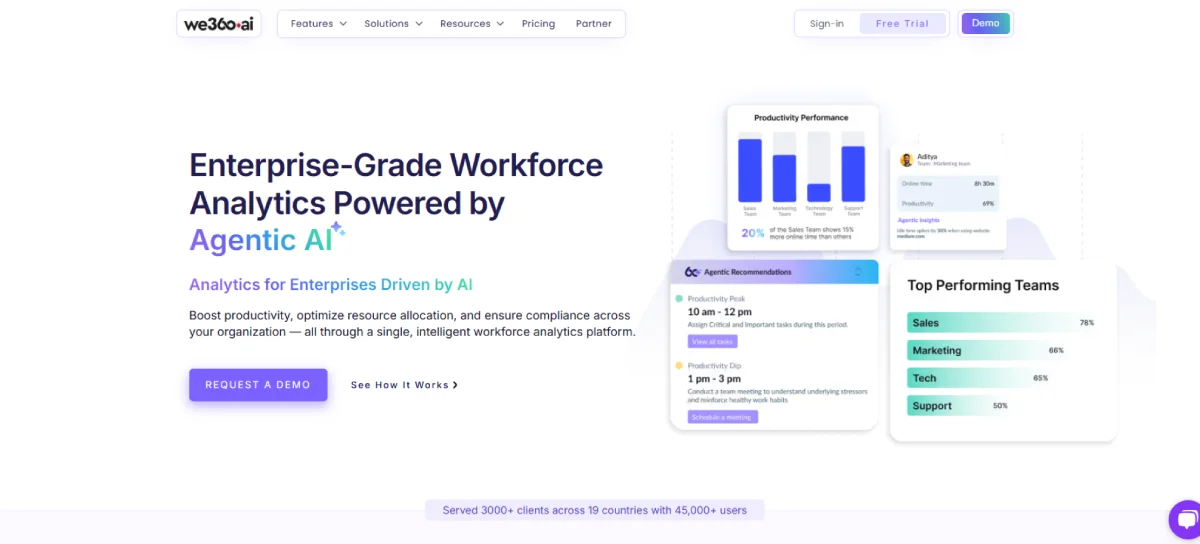
We360.ai is a cloud-based workforce analytics platform that runs silently in the background to track employee activity, attendance, app/website usage, and optional screenshots, helping managers gain real-time insight into productivity and workflow trends.
Features of We360.ai
- Activity tracking: shows real-time app and website use.
- Attendance tracking: logs login, logout, and break times.
- Productivity stats : measure active, idle, and unproductive hours.
- Screenshots : capture work progress at set intervals.
- Task tracking: helps manage work and monitor time spent.
- Reports : provide insights on team and individual performance.
- Alerts : notify you about unusual activity or idle time.
Pros & Cons
| Pros | Cons |
|---|---|
| Simple and fast setup | Sync delays and data lags |
| Real-time productivity tracking | Limited reporting customization |
| Domain blocking | App can slow down the computer |
| Responsive customer support | Mobile experience lacking |
Pricing
- Free : $0/User/Month with limited features.
- Starter : $5/User/Month
- Pro : $7/User/Month
- Enterprise : Custom planning
Ratings
- G2: 4.8
- Capterra: 4.3
8. ActivTrak
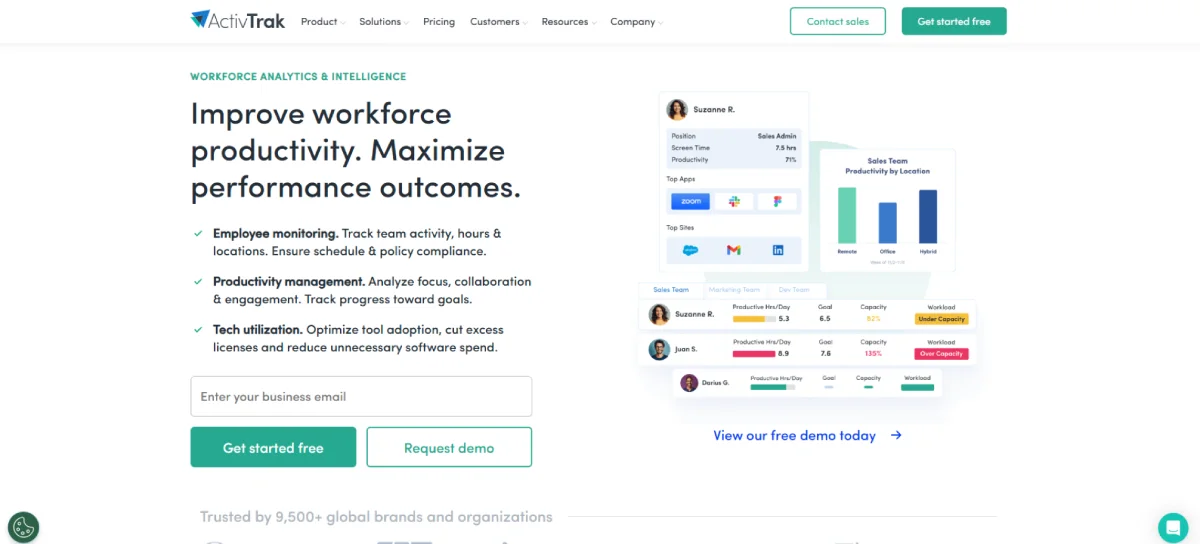
ActivTrak is a workforce analytics platform that runs in the background to track time, app/website usage, and productivity patterns, offering managers clear insight into how work gets done. With privacy-first settings and real-time dashboards, it helps hybrid and remote teams optimize performance, prevent burnout, and streamline operations.
Features of ActivTrak
- Remote visibility : helps monitor distributed teams.
- Integrations : connect with tools like Slack and Google Workspace.
- Workload balance: highlights overworked or underutilized employees.
- Activity tracking: shows which apps and websites are used.
- Privacy controls: protect personal and sensitive data.
- Alerts : protect personal and sensitive data.
Pros & Cons
| Pros | Cons |
|---|---|
| Easy to set up and use | Reports and options hard to navigate |
| Automatic background tracking | Performance issues |
| Detailed productivity reports | Limited free tier and pricey add-ons |
| Privacy-focused design | Lacks smartphone monitoring |
Pricing
- Free: $0/User/Month
- Essentials: $10/User/Month
- Essential Plus: $15/Use/Month
- Professional: $19/User/Month
Ratings
- G2: 4.4
- Capterra: 4.6
9.Insightful
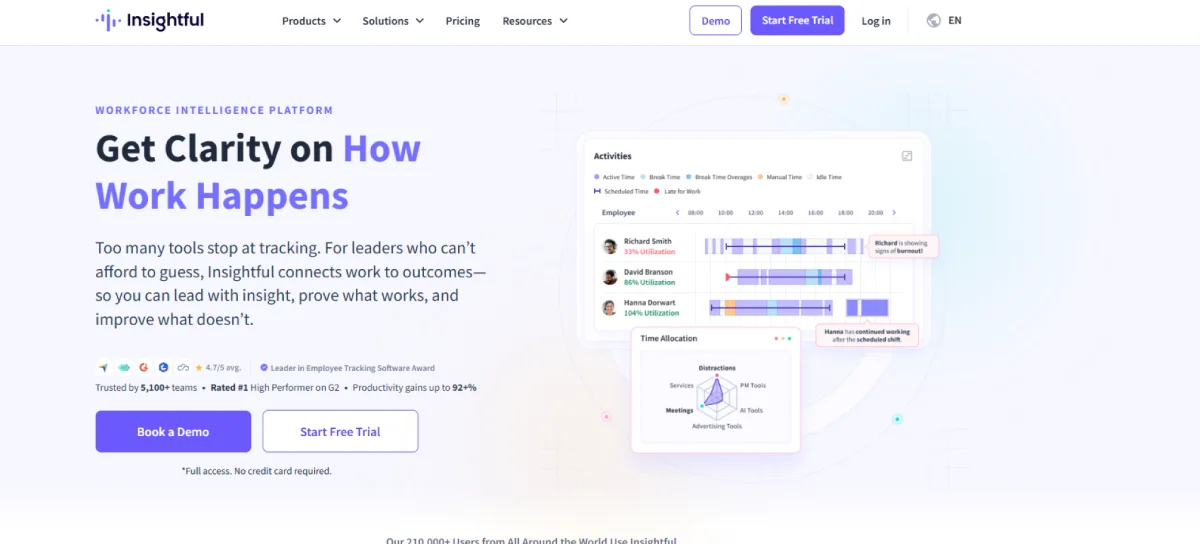
Insightful is a cloud-based workforce analytics tool that quietly runs in the background to track time, app and website usage, screenshots, and attendance, giving teams clear insight into productivity and workflow trends. With real-time dashboards, customizable alerts, and strong privacy controls, it helps hybrid and remote teams to optimize performance.
Features of Insightful
- Time tracking: logs hours automatically in the background.
- App and website monitoring: shows time spent on different tools.
- Screenshots : capture work periodically for visibility.
- Dashboards : display live team activities.
- Productivity analysis: highlights active and idle time.
- Attendance tracking : logs work hours and breaks.
- Custom alerts: warn about unusual activities.
Pros & Cons
| Pros | Cons |
|---|---|
| Strong workforce insights | Limited scheduling flexibility |
| Real-time productivity tracking | Reporting limitations |
| Great value for money | Mobile functionality gaps |
| Easy setup and use | occassional tracking inconsistencies |
Pricing
- Productivity Management: $6.40/Seat/Month
- Time Tracking: $8.00/Seat/Month
- Process Improvements: $12.00/Seat/Month
- Enterprise Solution: For teams of 100+/ Custom plan
Ratings
- G2: 4.7
- Capterra: 4.7
10. Teramind
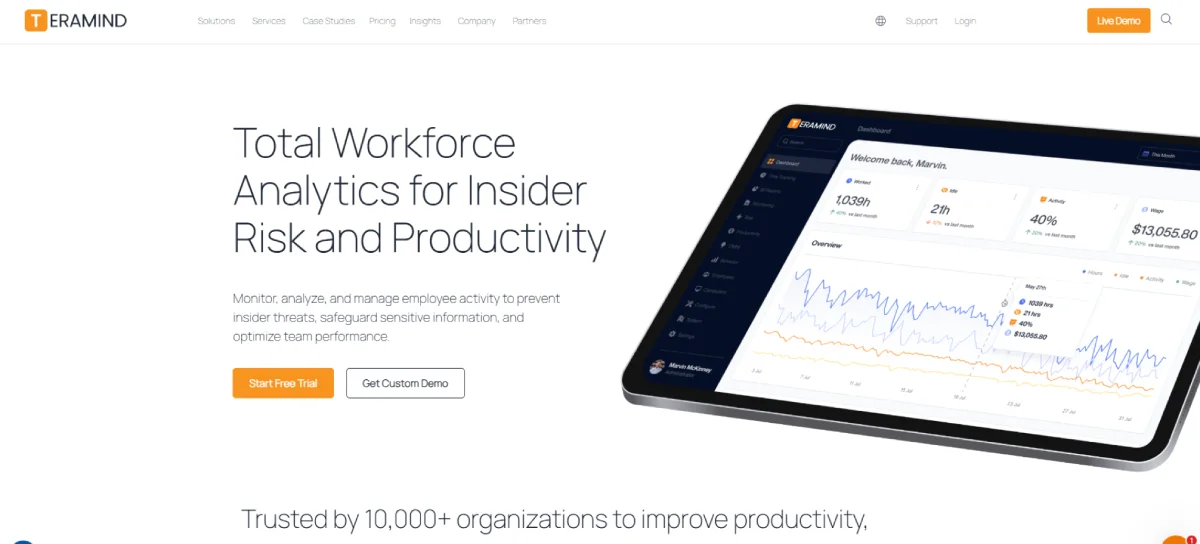
Teramind is an employee monitoring and data loss prevention platform specifically designed to help organizations track user activity, prevent insider threats, and ensure compliance. It offers real-time monitoring, screen recording, keystroke logging, and behavioral analytics to provide insights into employee behavior and productivity.
Features of Teramind
- User activity monitoring: tracks websites, apps, emails, and file actions.
- Screen recording : captures what users do on their screens in real time.
- Keystroke logging: records typed text to check for policy issues.
- Behavior tracking: helps spot unusual actions that could signal risks.
- Realtime alert: warns you if something suspicious happens.
- Data loss prevention: keeps sensitive files from being shared or leaked.
- Productivity tracking: shows how work hours are spent across tasks.
Pros & Cons
| Pros | Cons |
|---|---|
| Tracks user activity in detail | Expensive for small teams |
| Strong data security and compliance tools | Reporting limitations |
| Customizable rules and alerts | occcasional performance issues |
| Easy-to-use interface for a complex tool | Limited support for Mac and mobile |
Pricing
- Starter: $13.85/Seat/Month
- UAM: $27.70/Seat/Month
- DLP: $32.32/Seat/Month
- Enterprise: Custom pricing
Ratings
- G2: 4.6
- Capterra: 4.6
Smart Ways to Find the Best Tool for Your Team’s Needs
Choosing the right and perfect tool for your team can save time, increase productivity, and simplify work. So, which one is the best among the many options available? The following are some smart and practical ways to find the right fit:
1. Understand Your Team’s Pain Points
Before choosing any tool, you first need to understand what problems your team is facing.
Ex:
- Are tasks getting delayed?
- Is communication scattered?
- Am I wasting time on repetitive work?
By understanding what’s lagging your team down, you can focus on the tools that fix those exact issues.
2. Get Team Feedback
Involve your employees in the decision-making process. Enquire about their feedback regarding the tools. Find out what features they need, what tools they have liked previously. Their contribution makes the adoption of the product better and the workflow easier.
3. Set a Budget
Set a clear budget to prevent over-spending. Look at the long-term expenses and find tools where you can test before buying, such as flexible pricing, free trials, and freemium.
4. Compare Features Side by Side
Make a list of the tools you considered and compare their main features, usability, integrations, and support. This assists you to get the most appropriate tool for the needs of your team.
5. Read Real User Reviews
Look at trusted platforms like G2 and Capterra to find genuine user feedback. Real pros and cons, practical experience, and a clear idea of how well the tool is maintained over time are often shared in reviews.
6. Test with a Small Group First
Test a small group of employees to see how well the tool fits your workflow. After this gather feedback, make necessary changes if needed, and ensure that everything runs smoothly before launching it company-wide.
7. Think Long-Term
Select the tool that has the potential to support your team in the present and into the future as your team expands. Look for scalability, frequent updates, and quick customer support. A long-term tool will make you avoid switching in the future and keep your workflow uninterrupted as your requirements change.
Conclusion
When Handdy is no longer able to support your increasingly demanding needs, it's time to find more intelligent alternatives. The above mentioned top Handdy alternatives provide strong features, greater insights, and smooth workflows to make your team more productive.
Among them, Time Champ is an excellent choice if you have a modern, remote, or hybrid workforce, as it has an all-in-one solution, including productivity tracking, attendance management , project monitoring, and even GPS-based tracking.
Spend some time on testing the tool, engage your team, and get a tool that really grows with your business. The correct switch today can multiply the productivity and make your team work more comfortably and easily every day.
Frequently Asked Questions
Yes, integrations decrease manual work, synchronize data between tools, and make daily operations easy. Whether it's project boards, payroll software, communication tools or any other software - using a platform that integrates well will allow you to create a more efficient workflow.
Free tools are fine for basic tracking, but paid tools offer more features, accuracy, and support as well. For example, Time Champ includes attendance management, real-time productivity insights, and automated reports - making it a smarter investment for teams who are looking to scale.
Look for ease of use, accurate tracking, strong reporting, mobile access, and scalability. A good tool should support your team’s needs now and as you grow - especially if you have a hybrid or remote setup.
Choose tools with built-in privacy controls like user role settings, blurred screenshots, and restricted access. From the above list, Time Champ offers privacy-first options that help you monitor responsibly while maintaining trust and transparency with your team.
The majority of the cloud-based tools are easy to install within several hours. For example, Time Champ has a simple setup process with a user-friendly interface with easy onboarding.
Here are Some Related Articles You may Find Interesting

What is the Average Salary in Bangladesh: Overview & Insights
Discover The Average Salary in Bangladesh and outsourcing impact. Learn why it’s a rising player in global outsourcing.

Average Salary in India: Factors and Comprehensive Comparison
Discover the key factors influencing the average salary in India across industries, regions, and job levels, as well as insights.

What is the Average Salary in Colombia? & Factors Affecting
Discover the average salary in Colombia and explore the key factors affecting earnings, including industries, experience, and location. Find out.

What is the Average Salary in Indonesia?
Discover the average salary in South Africa and explore outsourcing trends. Learn key insights into wages, industries, and business opportunities.

What is the Average Salary in Hong Kong? and It’s Statistics
Learn about the average salary in Hong Kong, from minimum wage to maximum salaries, and gain insights into industry variations.

What is the Average Salary in Singapore: Economic Outlook
Discover the average salary in Singapore, key factors affecting income, insights into the nation’s economic outlook & explore its trends.
